top of page
Gunditj Mirring Fact Sheets
The Gunditj Mirring Facts Sheets were created to complement the 'Field Guide to Cultural Features of the Budj Bim Landscape'. The fact sheet include information about plants, animals and cultural heritage on the Budj Bim Landscape. The Fact Sheet were crated during the Gunditj Mirring Partnership Project.
bottom of page

























